Did you know that 30% of household garbage is organic and may be turned into nutrient-rich compost?
Composting at home could improve the environment and your landscape! With this in mind, we are delighted to present our ultimate guide on "How to Make Compost: Composting at Home Easily."
This detailed waste management guide will help you turn kitchen or food scraps and yard waste into garden gold while lowering your carbon footprint. Composting at home is an eco-friendly way to manage trash and makes an excellent plant fertilizer. Leave chemical fertilizers behind for lush backyard flora.
This blog covers composting basics, science, and lifestyle-friendly methods and instruments. Whether you live in an apartment or have a big yard, we've got you covered. Let's start composting today!
Benefits of Composting
Composting offers numerous environmental, economic, and gardening benefits. Here are some of the key advantages of composting:
1. Waste reduction:
Composting divert organic waste from landfills, reducing the volume of yard waste that contributes to methane emissions, a potent greenhouse gas.
2. Resource conservation:
By composting, you recycle valuable nutrients and organic matter instead of depleting natural resources to produce synthetic fertilizers and soil amendments.
3. Soil health improvement:
Compost improves soil structure, texture, and aeration, promoting better root growth and water retention. Composting yard waste also helps reduce soil erosion and runoff.
4. Nutrient enrichment:

Compost is rich in essential nutrients and micronutrients needed for plant growth, such as nitrogen, phosphorus, potassium, and trace minerals.
5. Enhanced soil biodiversity:
Compost introduces beneficial microorganisms to the soil, which can improve nutrient cycling, suppress pathogens, and promote overall plant health.
6. Disease and pest suppression:
The beneficial microorganisms in compost can help suppress soil-borne diseases and pests, reducing the need for chemical pesticides.
7. Improved plant growth:
Healthy soil and a more diverse soil ecosystem lead to stronger, more productive plants with increased resistance to diseases and pests.
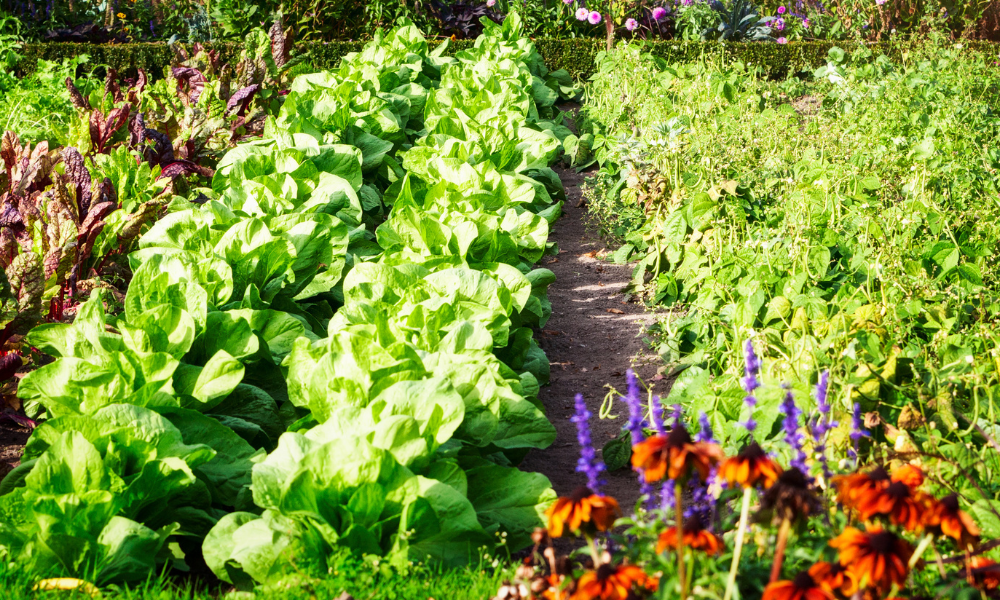
8. Cost savings:
Composting can save money by reducing the need for purchasing commercial fertilizers, soil amendments, and pesticides.
9. Climate change mitigation:
By reducing methane emissions from landfills and decreasing the reliance on synthetic fertilizers, composting contributes to the mitigation of climate change.
10. Environmental education:
Composting provides a hands-on learning opportunity for individuals and communities to understand better the natural processes of decomposition and the importance of reducing waste, promoting sustainability, and conserving resources.
By incorporating composting into your daily life, you can enjoy these benefits. Once the composting process is complete it contributes to a more sustainable and environmentally friendly lifestyle.
Choosing the Right Composting Method
Choosing the right composting method depends on various factors, such as available space, the type of materials you want, your desired composting speed, and how much maintenance you are willing to perform.
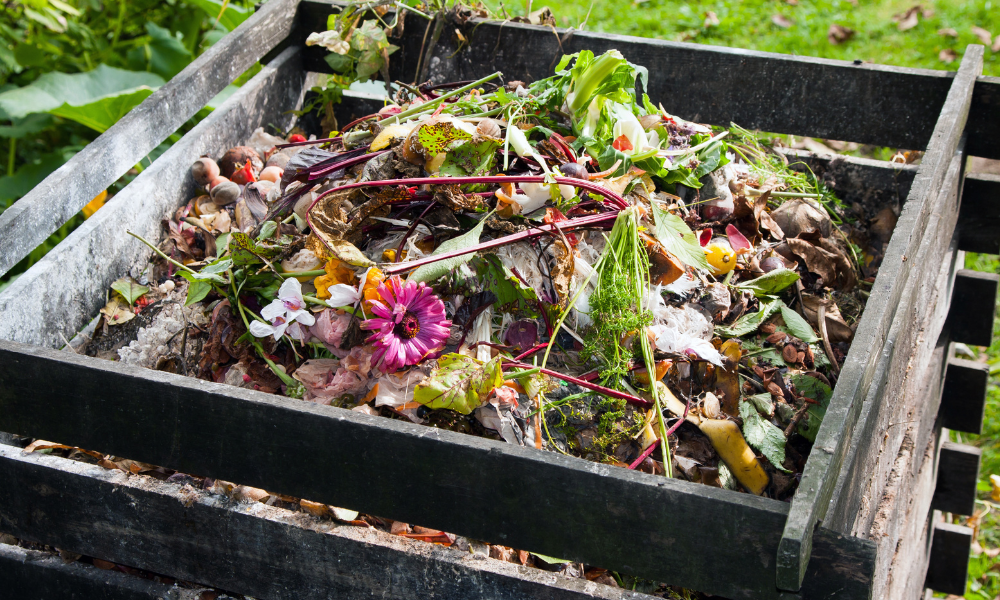
Here are some common composting methods to help you decide which one is the best fit for your needs:
Cold or passive composting:
Cold composting is the simplest method, perfect for those who have a small space or do not want to put in much effort. You can create a pile or use a compost bin to store garden waste, kitchen scraps, grass clippings and other organic material. The decomposition process is slow, taking six months to two years to produce finished compost.
Hot or active composting:
Hot compost method requires more effort but produces compost much faster (typically in 1-3 months). To achieve high temperatures that speed up the decomposition process, you must regularly turn and mix the compost pile, maintaining a balance between carbon- and nitrogen-rich materials. Hot compost method suits those with a larger space and who want quicker results.
Vermicomposting:
Also known as worm composting, this method uses red wiggler worms to break down organic waste in a contained system. It works well indoors or outdoors and produces nutrient-rich worm castings, which are excellent soil amendments. Vermicomposting is ideal for those with limited outdoor space or who want to compost year-round.
Bokashi:
This anaerobic method involves fermenting organic waste with the help of effective microorganisms (EM) in an airtight container. Bokashi composting is quick, usually taking 2-4 weeks, and can handle a broader range of materials, including meat and dairy products. After fermenting, the bokashi mix can be buried in the garden or added to a compost pile for further decomposition.
Trench composting:
This method involves digging a trench in your garden and burying kitchen scraps and other organic materials directly in the soil. The materials decompose slowly, enriching the soil with nutrients. This method requires minimal maintenance and is ideal for those with a garden but limited space for a compost pile.
Consider your specific needs, available resources, and the effort you're willing to invest in composting when choosing the best method. By selecting the right composting method, you can recycle your organic waste efficiently and create a valuable resource for your garden or plants.
What are the Materials Needed for Composting
To start organic composting, you will need a mix of organic materials like food scraps, grass clippings and and more. You need composting system or space to store the materials, and some basic tools to help manage the process.
Here's a list of materials and tools you may need:
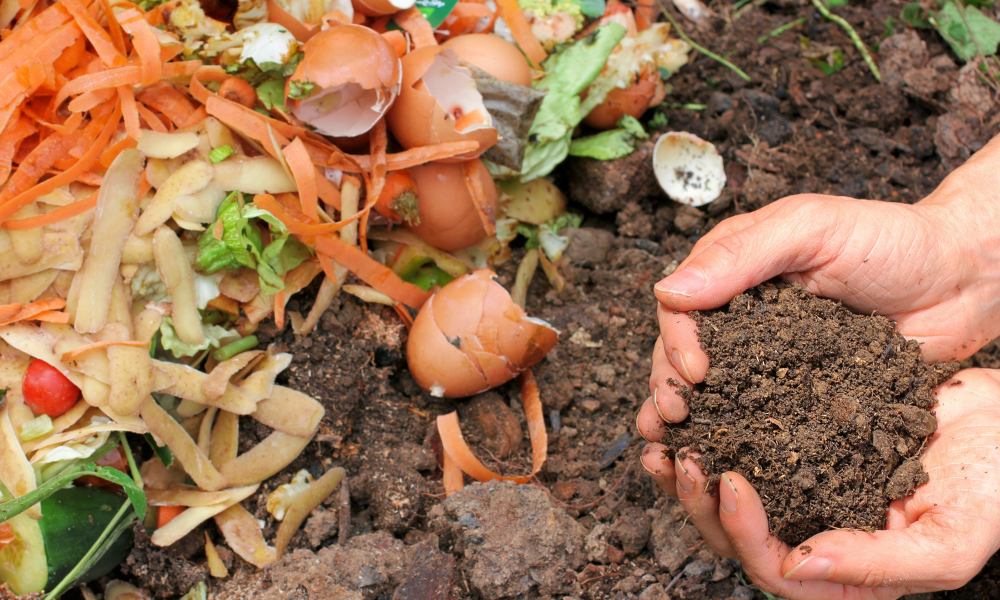
1. Organic materials:
Compost is made up of a mixture of carbon-rich ("browns") and nitrogen-rich ("greens") materials.
A. Carbon-rich Composting materials:
Carbon rich material, also known as "browns," are a vital component of compost. It's important to note that some carbon rich material can take longer to break down than others, so it's important to balance them with enough nitrogen-rich materials and turn the compost regularly to ensure everything decomposes properly. Here are some common carbon rich materials that can be used in compost:
-
Dry leaves
-
Straw or hay
-
Wood chips or sawdust
-
Cardboard or newspaper (non-glossy)
-
Small branches and twigs
B. Nitrogen-rich Composting materials:
Nitrogen-rich composting materials are essential for successful composting, as they provide the necessary nutrients for the microorganisms that break down organic matter. These materials are often referred to as "greens" due to their high nitrogen content and are balanced with carbon-rich "browns" to maintain an ideal C:N (3:1) ratio for decomposition. Here are some common nitrogen-rich composting materials:
-
Food scraps like fruit and vegetable
-
Fresh grass clippings
-
Coffee grounds
-
Tea bags (remove staples)
-
Eggshells (crushed)
-
Green plant trimmings
Avoid adding meat, dairy products, oils, fats, and pet waste, as they can cause odors and attract pests.
How to Make Compost
Making compost at home is an environmentally friendly way to recycle organic waste and produce nutrient-rich soil amendments for your garden.
Here are the basic steps to make compost at home:
-
Choose a composting method: Choose a suitable composting process based on your needs, available space, and preferences (e.g., cold composting, hot composting, vermicomposting, bokashi, or trench composting).
-
Select a location: Find a suitable place for your compost pile or container, preferably a level, well-drained area with some shade. If you're using a worm bin or bokashi bucket, you can place it indoors or outdoors, depending on your space constraints and preferences.
-
Prepare your composting system: Set up your compost bin, tumbler, worm bin, bokashi bucket, or designated compost pile area, following the guidelines for your chosen method.
-
Collect materials: Gather a mix of browns and greens materials like grass clippings. Remember to chop or shred more extensive materials to speed up decomposition.
-
Layer the materials: Start with a layer of coarse materials (e.g., twigs, small branches) for aeration at the base of your compost pile or bin. Then, alternate layers of browns and greens. Generally, aim for a ratio of 3 parts browns to 1 part greens by volume. This ratio helps maintain a healthy balance of carbon and nitrogen, crucial for efficient decomposition.
-
Monitor moisture and aeration: Keep the compost pile moist but not soggy. The moisture level should be like a wrung-out sponge. Turning the pile with a pitchfork or garden fork regularly (every 1-2 weeks for hot composting) will help aerate the compost and speed up decomposition.
-
Check temperature (optional): Monitor the temperature using a compost thermometer for hot composting. Ideally, the pile should reach 130-160°F (54-71°C) to kill pathogens and weed seeds while promoting rapid decomposition.
-
Observe decomposition progress: Over time, the pile's volume decrease and the materials look like dark, crumbly soil. Depending on the composting method and conditions, this process can take a few weeks to several months.
-
Harvest and use the compost: Once it is dark, crumbly, and has an earthy smell, it's ready to use. You can sift it through a screen or mesh to remove larger, undecomposed materials. Apply the finished compost to your garden beds as potting soil or mix it into your lawn.
By following these steps and regularly maintaining your compost pile or system, you can produce nutrient-rich compost that will benefit your garden and reduce the amount of organic waste sent to landfills.
Tools and Equipment for Home and Backyard Composting:
Depending on your chosen composting method, you'll need an appropriate container or space for your compost pile.
Compost bin or tumbler:
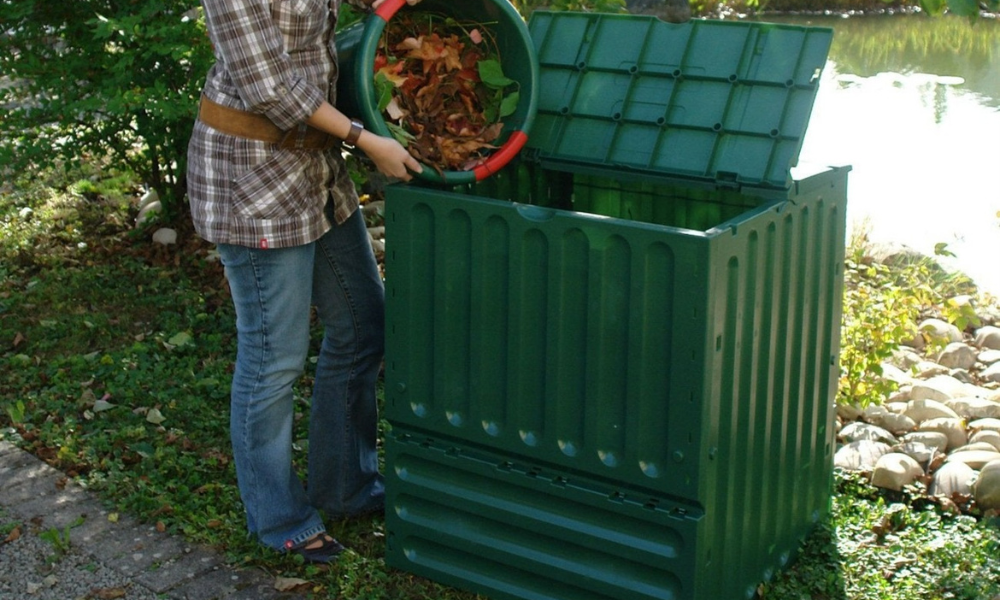
Several compost bins are perfect for backyard composting or home composting. Compost tumblers can be purchased or made from various materials, including wood, plastic, and metal.
Types of Home Compost Bins-
Tumbling Compost Bins: Also known as compost tumblers, these are mounted on a frame and can be rotated to mix the compost materials easily. They're often made of plastic or metal and come in single or dual compartments. Tumblers tend to produce compost more quickly than stationary bins because they provide better aeration and facilitate more frequent turning.:
-
Enclosed Bins: Enclosed bins are a popular choice for home composting because they help contain odors, deter pests, and provide a neat appearance.
-
DIY Compost Tumblers: A DIY compost tumbler is a simple and effective way to create compost at home. A tumbler speeds up the decomposition process by making it easy to turn and aerate the compost regularly.
-
Vermicomposting Bins: A special container with a lid and ventilation holes designed for worm composting.
Bokashi bucket:
An airtight container for fermenting organic waste using bokashi bran.
Garden fork or pitchfork:
Useful for turning and aerating compost piles.
Spade shovels:
Help add and remove materials from the compost pile and dig trenches for trench composting.
Gloves:
Protect your hands while handling compost materials.
Thermometer:
A compost thermometer helps monitor the temperature of your compost pile to ensure optimal decomposition.
Wire mesh or hardware cloth:
It can be used to cover open-air compost piles to prevent pests and maintain moisture levels.
Food waste digester
Food waste digesters turn trash into water, carbon dioxide, and nutrient-rich byproducts. These systems efficiently process and reduce food waste in homes, businesses, and factories. Mechanical, biological, and anaerobic food waste digesters exist in many sizes.
Food waste digesters reduce greenhouse gas emissions, provide useful byproducts, and lessen the environmental impact of waste disposal. Food waste generation, space, and end products determine the best digester.
Remember to balance carbon- and nitrogen-rich materials and ensure adequate moisture and aeration in your compost pile. This will help promote decomposition and create nutrient-rich compost for your garden.
Common Composting Problems and Solutions
Composting is an excellent way to recycle organic waste and create nutrient-rich soil for your garden. However, some common problems may arise during the composting process. Here, we discuss some of these issues and offer solutions to help you maintain a healthy compost pile:
-
Foul odor: A strong, unpleasant smell from your compost pile is often due to anaerobic conditions caused by a lack of oxygen and excess moisture. Solution: Turn your compost pile regularly to ensure proper aeration and drainage. Add dry, carbon-rich materials like, coffee grounds, leaves, straw, or shredded paper to balance out the moisture.
-
Slow decomposition: If your compost pile is not breaking down quickly, it could be due to an imbalance in the carbon-to-nitrogen ratio or a lack of moisture. Solution: Ensure a proper balance of green (nitrogen-rich) and brown (carbon-rich) materials. Keep the pile moist by watering it occasionally but be careful not to overwater.
-
Pest invasion: Flies, rodents, and other pests can be attracted to compost piles, especially if they contain food scraps, pet waste, . Solution: Keep your compost pile covered with a layer of carbon-rich materials like leaves, straw, or wood chips. Avoid adding meat, dairy, and cooked food scraps, as these can attract pests.
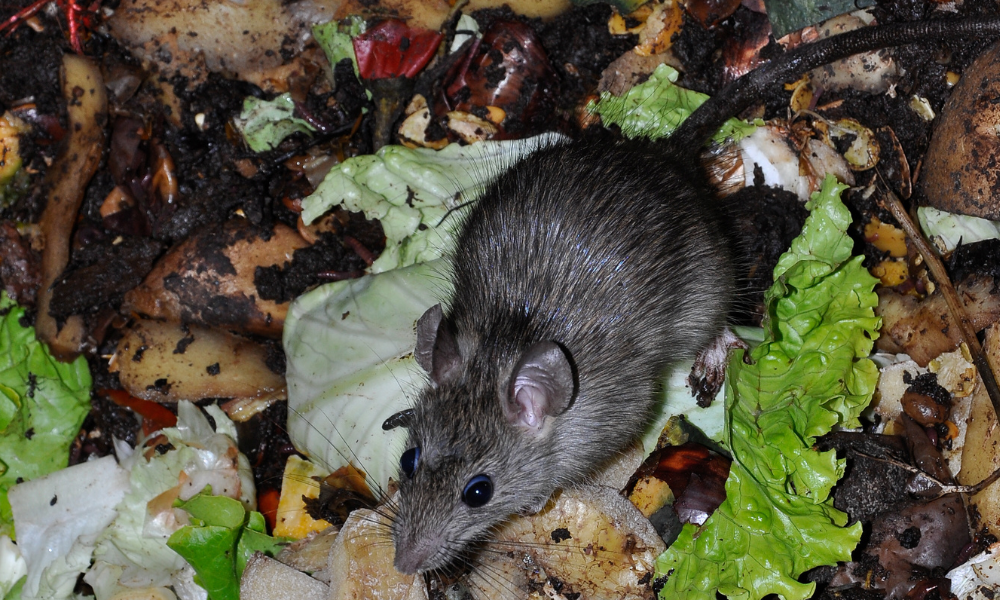
-
Uneven decomposition: Your compost pile may have unevenly decomposed materials, with some parts decomposing quickly while others remain mostly unchanged. Solution: Make sure to turn and mix your compost pile regularly to distribute the materials evenly and provide better aeration.
-
Compost is too dry: A lack of moisture can slow down the decomposition process, resulting in a pile that does not break down effectively. Solution: Water your compost pile occasionally to maintain proper moisture levels. Cover the pile with a tarp or other material to help retain moisture.
-
Compost is too wet: An overly wet compost pile can lead to anaerobic conditions, foul odors, and slow decomposition. Solution: Turn the pile to improve aeration and add dry, carbon-rich materials like leaves, straw, or shredded paper to help balance the moisture content.
-
Temperature issues: A compost pile that is not heating up may not decompose properly, while one that is too hot can kill beneficial microorganisms. Solution: Ensure your compost pile balances green and brown materials and maintains adequate moisture levels. For larger piles, turn them regularly to distribute heat evenly.

By addressing these common composting problems and following the suggested solutions, you can create a healthy, thriving compost pile that provides nutrient-rich compost for your garden.
Using Your Finished Compost
Once your compost is finished and has transformed into a dark, crumbly, and earthy-smelling material, you can put it to good use in your garden and landscaping projects. Here are some ways to utilize your finished compost:
-
Soil amendment: Incorporate your fresh compost into your garden soil to improve its structure, fertility, and water-holding capacity. Mix the compost with existing soil at about 1:3 (compost to soil) for best results.
-
Mulch: Apply a layer of compost around the base of your plants, shrubs, and trees. This helps to suppress weeds, retain soil moisture, and slowly release nutrients into the soil. Be sure to leave some space around the plant stems to prevent rot and pest issues.
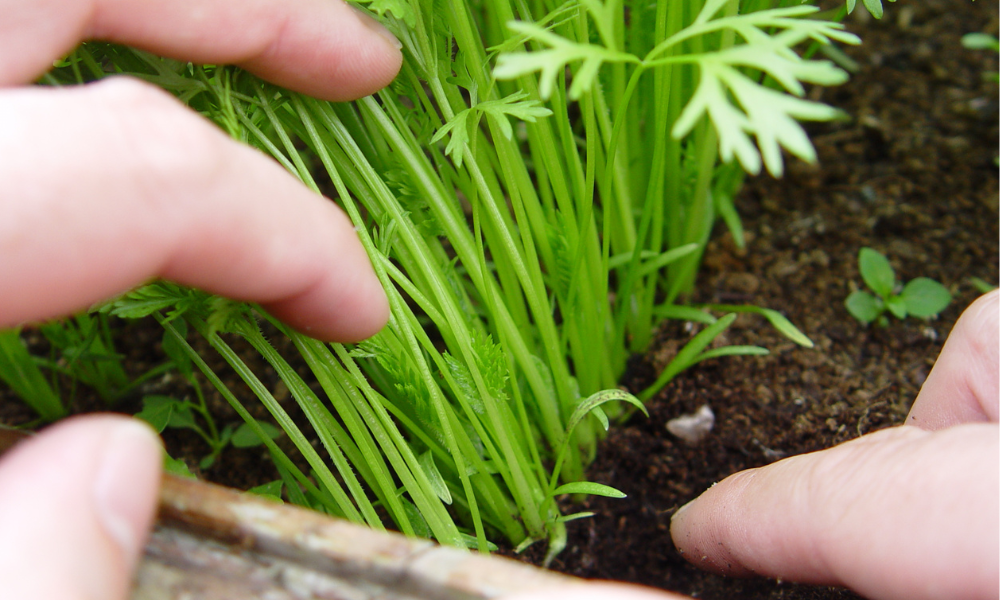
-
Potting mix: Create your own nutrient-rich potting mix by combining equal parts compost, garden soil, and drainage components like perlite, vermiculite, or coarse sand.
-
Top-dressing lawns: Spread a thin layer of compost (about 1/4 to 1/2 inch) over your lawn to improve the soil structure and provide nutrients. This can be done in the spring or fall when the grass is actively growing.
-
Planting trees and shrubs: When planting new trees or shrubs, mix compost into the planting hole to provide nutrients and improve soil structure, encouraging strong root growth.
-
Vegetable gardens: Incorporate compost into your vegetable garden beds before planting. This will provide essential nutrients for the plants and improve the soil structure, helping to promote healthy root development.
-
Container gardening: Mix compost with potting soil for your container plants to provide a slow-release source of nutrients and improve the overall health of the plants.
-
Seed starting: Combine compost with equal parts of perlite, vermiculite, or peat moss to create a seed-starting mix that provides nutrients and good drainage for seedlings.
Remember to use your finished compost wisely, and don't worry if you have more compost than you can use immediately. Finished compost can be stored in a covered, well-ventilated area for several months without losing its beneficial properties. Just keep it from drying out completely or becoming overly wet.
Conclusion
In conclusion, composting yard waste is a rewarding and eco-friendly practice that benefits your garden and the environment. Recycling organic matter creates a nutrient-rich soil amendment that helps improve soil structure, boosts plant health, and reduces the need for synthetic fertilizers.
Moreover, composting at home plays a vital role in reducing landfill waste and greenhouse gas emissions. Composting your food scraps are a valuable contribution to a greener and more sustainable future.
Please share any composting tips or ideas in the comment section. Sharing your composting experiences can inspire others to preserve the earth. Together, we can enhance our gardens, the environment, and society.
You can visit Hardy Garden for different gardening guide additionally you can find different composters that suits your needs.
Happy composting!





Share and get 15% off!
Simply share this product on one of the following social networks and you will unlock 15% off!